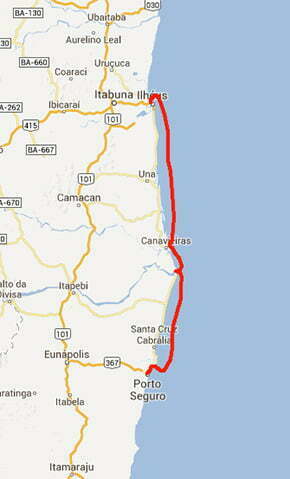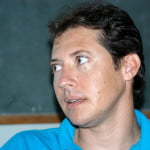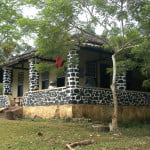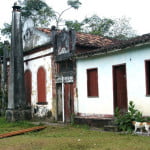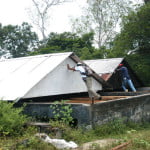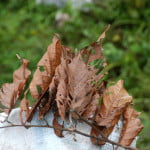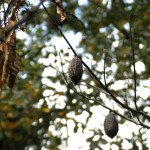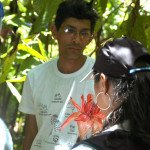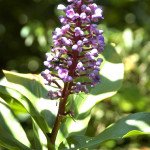Wednesday, 08 – 03 – 2006.
In the last logbook, I said I was going to get more information on Conama’s Resolution passed on February 22, as well as on the APPs (Permanent Preservation Areas) in order to make comments about both. Well then. During my stay in São Paulo I got some information on that. I lost hope. After having discussed the issue for four long years, the National Environmental Council decided in an election year – pay attention, please, – to make legal what was illegal, rewarding all those who didn’t act according to the environmental legislation. They alleged that reverting some situations would cause “social damages”. Let’s try to understand the situation. According to the last Forest Code, it was stipulated that some areas should be compulsorily preserved. These areas are extremely important such as river banks and sources which are fundamental for water quality and supply; mangroves which are important for maritime life reproduction and the coast line protection; sand bars where the influence of tides is predominant; the tops of hills and mountains which are risky areas due to erosion; the preservation of slopes where there are land slides because of the rain, etc.. Since there is lack of inspection and most people and companies know that, most of these areas were irregularly occupied as time went by. Our mastodon and inefficient State didn’t do anything, as usual. Time went by and the situation came true. Then Conama decided to discuss the issue. There are 111 people who are members of the council, most of them are connected with the government, but there are also environmentalists, people from the academic community and NGOs. Then came the February Resolution which encouraged impunity by making legal what was illegal. It is as simple as that. The main argument is “social damage”. Some people say that the government doesn’t have enough money to remove low income people who live in source areas and offer other ones.
At the core of this suspicious speech (there is enough money, but it is lost in many holes, briberies, corruption, etc.); mining activities are rewarded as well, most of the time in APPs such as the tops of the hills, river banks, etc.. And who cares about the environment, the biodiversity preservation and the commitment of our generation “to hand in” nature to future generations as it was given to us, if possible, better than it was. It is absurd. What about those who respected the legislation? What about those powerful businessmen and unscrupulous politicians who devastate mangrove areas to breed exotic shrimps and become rich? Besides getting public funds, will they be offered additional rewards? What about those monstrous resorts built on the beaches which devastate a public paradise like scenery, will they continue to destroy what doesn’t belong to them, fill their coffers with this and additionally get this little help? I will give to Conama’s members the “Bold Front Award” – the abject Oscar award “I like when you cheat me”. That’s all that comes to my mind now. From Ilheus’ airport, which is practically downtown, we went straight to South Bahia’s Social Environmental Study Institute (IESB) to make a couple of interviews. We talked to Marcelo Araujo, this NGO’s executive secretary. He told us about the difficulties faced by cacao farmers, the area’s main economic activity, at the end of the 80’s with the arrival of a fungus which causes a disease known as the “witch’s broom”. He told us that this resulted in approximately 250 thousand unemployed people in the country, woodcutters’ pressure, the increasing eucalyptus monoculture which is spreading in the north of Bahia, etc. IESB’ s work seems very serious to me. It is worth finding out more about it. And this can be done if you visit their web site or if you read what comes next. The cacao tree is originally from the Amazon Bay and arrived in Ilheus at the end of the 18th century and the beginning of the 19th. It soon became the biggest economic strength. To be fruitful, cacao needs to grow in fertile soil in the shade.
That’s the reason why it adapted itself perfectly in the rich Atlantic Forest of the south of Bahia. And the barons of those times became rich with it. Since 90% of the production was exported at a good price, this culture became very important all over Bahia. The trees were planted in the middle of the forest which in a way helped to preserve it. Now, with the crisis, remains the threat that farmers full of debts plant eucalyptuses instead or carry out any other activity that devastates what is left from this biome in Bahia. Here starts one of the most important IESB’s tasks: to help producers not do depend exclusively on cacao profits by making them plant other cultures simultaneously and to help them to get rid of the plague that infests their plantations. If they succeed, they will help to preserve what remains in the Atlantic Forest in the south of Bahia. Marcelo told us about other pressures such as the illegal activity known as “big boards”, that is, small woodcutters enter into the forest with equipment cut down the trees and process the wood right there and leave the Atlantic Forest with trees turned into wood boards; this explains the name. There is also the activity of hunting and smuggling wild animals (Bahia is the state where smuggling wild animals is most practiced) among others. I enjoyed the talk we had as well as IESB’s people and the atmosphere. We scheduled for tomorrow morning a visit to a cacao farm and said goodbye. Afterwards we went to our floating house, my boat, the Endless Sea, anchored behind the break-water of Ilheus’ port quite in front of Yacht Club.
As usual Alonso Goes was waiting for us, this species which is almost extinct, one of the last professional sailors devoted to leisure boats. He is 100% a sea man and has much experience, a master in his craft. We were happy to meet him again. Paulina Chamorro, who had been working in São Paulo for a while, joined us again on the trips. Movie maker Paulo Cezar Cardozo was with us as well. We talked for a while, had dinner on board and went to bed. Tomorrow morning we are going to visit the farm, fill the boat with provisions and sail a little bit more than 50 miles to Canavieiras.
Thursday, 09 – 03 – 2006.
It was 7:30 a.m. when we met Joaquim Blannes (whose nickname is Peninha) and Luciano Lima. Joaquim is an environmentalist who works for IESB. Luciano is a farmer. Both were taking us to an old unproductive cacao farm, where approximately 20 homeless families were settled and continue to try to save crops to live from them. It took us 30 minutes to go from the Yacht Club to the farm. We took the coastal road northwards and then a detour where there was an unpaved road. We drove for some minutes and saw a beautiful mansion with a red flag and a few houses around it where there used to be an old colony.
It dates from 1923 (we saw it on a plaque). In addition to the colons’ houses which are occupied today by the homeless, there was a shed used to store the production and two drying systems known as barges which are in fact two long rectangular cement buildings protected by a roof hanging on lateral rails in order to be easily removed. Cacao fruits were put in the rectangles (like coffee grains on the land). During the day the roof was opened so that the fruits were dried by the sun and during the night it was covered to avoid mist. We walked in search of cacao trees planted in the middle of the forest. My attention was immediately grabbed by huge bromelias on the branches of the trees, of different types and sizes. Some of them were huge. But all of them were very beautiful. However, it was not nice to see dry cacaos and leaves with no life with holes made by funguses which cause a drastic genetic change. Some trees are still productive after 80 years and they can be over 12 meters high, but they are not cut to make crops easier. In the settlement, the area is covered either by hog plum trees or rubber trees, according to the diversification strategy encouraged by IESB and all of them are treated organically. The first cacao’s crisis was in 1929 which resulted from the American stock market crack. The price fell vertiginously. From 1930 to 1950, there were added difficulties. At the end of the 50’s, there was cacao’s worst crisis. The activity was anti-economical due to the lack of credit, low prices in the international market, high production cost and plagues. Unemployment increases and many agricultural workers gave up and abandoned their crops. The government founded CEPLAC – “Executive Commission of Cacao Crops Rural Economic Recovery Plan”, an agency linked to the Agricultural and Agrarian Development Department from the Federal Government. However the storm was not weaker. A worse crisis was to come. At the end of the 80’s, there was a fungus which destroys the fruit in the tree and it doesn’t cause any harm to the tree. There is no remedy against it.
Farmers and CEPLAC work together and invest in cacao’s research. They find out that the only way to solve the problem is to clone the tree with a resistant type of fungus. But the process is expensive and relatively slow. Additionally, the farmers have debts “still crying because of their past losses”, according to what we were told. They are also discouraged. Meanwhile, Ilheus’ neighboring areas are full of slums, most of them have recently emerged due to the “witch’s broom” plague, and this is how the cacao plague is called. Today, the biggest disagreement between environmentalists and CEPLAC is the fact that the latter supports the idea that cacao doesn’t really need shade and suggests that only 12 native trees might be planted per hectare; whereas environmentalists insist on keeping at least 60 to maintain what is left in Ilheus’ Atlantic Forest area as well as in the south of Bahia. I’m not an expert in this field so I cannot give my opinion.
Nevertheless, I support the environmentalists’ idea. From the settlement we returned to the city and went southwards to visit Luciano’s small farm with 24 hectares, which is seen as a model. Everything is treated organically, with no pesticides and it is certified. Apparently, there is a close forest with wonderful centennial trees with marvelous leaves among them; there are different types of green, sophisticated geometric shapes with cacao trees, cupuaçu trees, lime trees, banana trees, peach palm trees, assai palm trees, graviola trees, coconut trees as well as approximately thirty beautiful beds of flowers from the Atlantic Forest or from humid forests. One of the most beautiful and exotic is popularly called “big ice-cream” (see pictures). It was nice to see the complicity between Peninha (Joaquim Blannes) and Luciano. They are friends and one admires the other. They play all the time. What really connects them is their passion for the environment and the enthusiasm for what they do. We entered in the dense forest with no visible tracks covered by plants to the top of the van and Luciano pointed out the direction that had to be followed, and Peninha obeyed him blindly right away.
It was impossible to see anything a meter ahead of us, not even where we were going through; we could only feel jolts in the 4x 4 van or the abrupt downward slopes when the car seemed to drop in a huge hole where we would stay for the rest of our lives. From time to time, Luciano asked to stop. The side door could hardly be opened because the forest was very dense. Then, a poet or a philosopher would leave the car and like a guide he would walk in front of us amazed with everything he saw, showing us the beautiful flowers he explores. With a jackknife in his hand, Luciano chose the most beautiful flowers and cut at the stalk and gave them to Paulina. The bouquet was increasingly bigger with colors from purple blue to yellow, pink and light red. The shapes were completely unusual. I had never seen anything of the sort. Marvelous. Luciano didn’t stop saying that the experience of the farm was successful. With only one of the cultures he could pay costs. With the rest he got profit. Everything was organic, certified by IBD, it remunerated capital, generated jobs, and above all, without cutting the trees and turning them into boards, the only way to keep our biodiversity. Congratulations.
Finally they took us to the banks of the Engenho River, not far from there, to see “Brazil’s second oldest church”, so they say. We are not sure about it since during our journey sometimes we are told the same story. We went there anyway. A nice idea. It was really picturesque, typical and beautiful. The small church is there (see pictures), facing the mouth of the river “so that Jesuits could see the Dutch before they arrived”. We shot it and took pictures, and then we returned to Ilheus. Before, we stopped in a nice restaurant where a barbecue with rice, banana with golden-fried manioc, green beans and salad was waiting for us. After the banquet our friends left us at the Yacht Club. It was about 3 p.m. It wasn’t possible to go to Canavieiras today. We have to arrive there when there is daylight because the bar is obstructed and dangerous. It is better to sleep in Ilheus tonight and leave tomorrow morning.
Friday, 10 – 03 – 2006.
We had to do lots of things yesterday. While we were refueling the Endless Sea with diesel and fresh water at the end of the afternoon we found out that the shooting camera was broken. We had shot with it two days ago, but it was broken yesterday. It was 6 p.m. when we noticed that… It couldn’t be worse! We called the producer, warned them and a few minutes later Adriana Cerdeira took another one to Congonhas airport. It arrived in time. On the cell phone, we were told that the 10:30 p.m. TAM EXPRESS flight would bring it here.
We decided to face the boring task of going to the supermarket. As soon as we unloaded all the things and bought on board, it was time to pick up the camera. We went to the airport. Fortunately, it worked out. We were on board at midnight, the sailboat had been filled, and there was a new camera ready for our trip. It is 9:30 p.m. and people on board are complaining about hot weather. We had a calm and beautiful trip with the sail up helped by the current and a favorable wind of 7,5 and 8 knots. Without swinging. The northeast wind blew all the time, at first weakly, but it became stronger as the day went by. When we arrived it was ranging from 14 to 18 knots. We were lucky. There was low tide, that’s the reason why waves were splashing from everywhere. We entered behind a fishing boat which stopped to wait for us. It was a very kind attitude. And they helped us to get in.
At the low tide, we reached a depth of 1.5 meters, it was scary. However, as soon as we overcame the critical moment, it was deeper. We found no difficulty in arriving in the city a few miles up the mouth of the river. Tomorrow we will explore this area. The biggest problems are crustacean culture, tourism and real estate speculation. Anyway, along the few miles we crossed from the sea to arrive here, we were able to see a wonderful landscape, with mangroves on one side; beaches and coconut tress on the other, a few houses on the banks.
Saturday, 11 – 03 – 2006.
At 7:30 a.m. we met Anders Schmidt and Mauricio Arantes, Ecotuba Institute’s biologists, a NGO operating here in the south of Bahia. There was also a nice pilot “Bigode” and the three of them took us on a motor boat to visit the area. We sailed for 20 minutes towards the mouth of the river and met a crab hunter who we wanted to talk to. On the bank of the river, we shot him hunt the crabs buried in the mud of the mangrove. Then we recorded an interview and started to go up the Pardo River. We wanted to see how it had been occupied, the pressures of tourism, etc. Fortunately, it had just started and the beaches here do not correspond to what people normally have in their minds when they think of a paradise type of beach. Due to the presence of several rivers, the water is not transparent and the sand is not always white.
Geography has moved mass tourism away so far. The other advantage is the fact that Canavieiras is in the middle of a lagoon, surrounded by mangroves and rivers, and this ecosystem is not what tourists prefer. Anyway, undertakers and speculators are coming, and they will establish themselves sooner or later. There are just a few pousadas, especially on Atalaia Island and they don’t deteriorate the natural scenery. After we left the city, we took a small affluent and went straight ahead. It was a wonderful tour. As the river becomes narrower, the crowns of the mangroves from both banks form vegetation tunnels. Our boat slipped out under the leafy vegetal cover zigzagging among branches and tree trunks. On the banks, we could hear the buzzing noise made by the trunks and suspended roots trying to find a support. On our way, we saw several dead catfishes floating on the water. We asked what could have killed them and when we arrived at the end of the river, we saw many pumps in the water from a shrimp farm.
We left the boat to shoot it. During part of the shooting, I warned people about the fact that the Endless Sea Project has been the only voice so far to denounce the damage caused by the crustacean culture spree. Rio and São Paulo’s important NGOs act like Lula: “they haven’t seen anything, they don’t know anything”. It is unbelievable, even NGOs which were founded to fight for the remaining Atlantic Forest don’t say anything. During part of the program, I said: “Watch out: they are devastating the green of our forests… to breed shrimps from the Pacific instead. We pay for all that, whereas businessmen and politicians who exploit this disastrous type of crustacean culture become richer.” We returned to the Endless Sea at the end of the day. Anders, Mauricio and other fellows came on board. They came to visit the sailboat. We drank lime caipirinhas with the fruits brought from the farm we had visited in Ilheus, and we talked about RESEX which Ibama is about to found here. When I interviewed Ibama’s executive manager in Salvador, Julio de Sa Rocha, he said that they intended to create an extraction reserve in Canavieiras to be the counterpoint to Bahia Pesca’s determination to turn the area into another crustacean culture pole as well as to stop predatory tourism. According to Julio, the legislation of an Extraction Reserve requires more restriction than that of APAs and it might avoid the devastation of this lagoon.
Ecotuba, IESB and Pangea work here; so far they have tried to make local inhabitants understand the advantages of RESEX. But it will be difficult. Local inhabitants don’t realize they have always occupied lands that are old maritime areas, that is, public areas that belong to the government; local inhabitants just have the possession title. During the hearings which took place before the foundation of RESEX, they were told that nothing would change, just the fact that they couldn’t sell their possessions (in fact it has always been like this…). However, this was enough to bring distrust, rancor towards the omission of public power,” which wants to come here now and tell us what to do”, and fear. Meanwhile, speculators take advantage of the troublesome situation and instigate bad reactions by spreading alarming rumors. Thus local inhabitants get more confused. Our friends, the environmentalists, will have hard work. They left the boat and returned to their bases before the sunset. Then we had lunch, rested and prepared ourselves for tomorrow when we will try to enter through the mouth of the Jequitinhonha River which is less than ten miles down from us. At least we will have enough time to sleep since there will be high tide at 3 p.m. We will have a morning free to sleep. We will leave Canavieiras after midday. How nice, this is rarely possible on board. Let’s enjoy it.
Sunday, 12 – 03 – 2006.
It is 8:30 p.m., a day full of emotions. Right now I am fighting against carapanãs, some type of tiny winged devils which attack constantly making me use my hands either to write or to scratch the bitten parts and hit the most daring insects. It is hard to concentrate in this battle. No other insect is more annoying than this one! It is so small that you can hardly see it, but it has such a powerful bite that makes you scratch constantly. Using a mosquito repellent is the only possible way. Well, now I have spread repellent from head to toe, I can tell what happened to us. After a night of strong rain, I woke up at 9 a.m. I had hardly had breakfast when a young man arrived in his canoe. We had met him yesterday at the pier. As soon as he saw us, he complimented us on our program and mentioned with enthusiasm different parts of it and he rushed to greet us. He was so nice and spontaneous that I invited him to come on board today. And he came. He spent hours with us. He talked to us and showed he is aware of the situation in Canavieiras.
There was also this nice view of Canavieiras’ colonial row of houses from the street that leads to the port which has been recently renovated; everything is very well treated and beautiful. We dropped anchor at the pier of the city to get some water and leave our TV viewer. Raimundo, a “pilot”, got on board instead; saying that he knew the Jequitinhonha River’s bar. This bar is so obstructed that even fishing boats find it difficult to enter in it. While we were getting the water, we talked to people who were at the pier watching us. They said that we were going to make it, especially due to the fact that it was a full moon period when tides are higher; however, they insisted we needed a pilot from there, if possible. But we weren’t able to get one. That’s when Raimundo showed up saying he knew the bar. We went with him. The tide was completely high between three and four p.m. We started to sail at one. We went out through Canavieras’ bar without any problems and went towards Belmonte. I used the automatic pilot and went down to cook. We had just the mizzen sail up and the motor was on, there was almost no wind. About fifty minutes later, I got back to the cockpit with a plate full of pasta in my hand.
Alonso and Raimundo were trying to remove a fish from the line which is thrown every time we sail. But the fish escaped. Our prow was almost reaching the bar. I continued to eat and Alonso was at the rudder following the instructions of the pilot; but at the first assault a little bit too much towards the left of the bank, the splashing waves of one meter high, sometimes one meter and a half, made our keel hit violently the hard bottom of sand. The whole boat was shaken. The mast bent forwards and backwards several times; the wave passed and we stayed; we lost the rudder and the prow of the sailboat rotated through 180 degrees, outwards again. We were stuck. The situation was critical on board! I opened the genoa immediately (the prow sail). I hope the weak wind heels the sailboat and releases the keel from the bottom. But the Endless Sea could only be released at the top of the wave and it hit the bottom again when it fell in the hole. Fortunately, it didn’t lie sideways. We felt the keel hit the bottom of the sea. To make things worse, the cable of the rubber boat which was attached was caught by the propeller. Now the situation was really bad! Alonso couldn’t make the motor be more powerful, the sailboat didn’t move only upwards and downwards because of the waves. The propeller was stuck. I went there to see it and noticed that the prow of the rubber boat was down moving towards the axle of the propeller.
A knife was given to Raimundo who tried to cut the cable through the stern frame. I jumped into the boat and asked Cardozo to release the stern. I intended to release the stern motor. I wanted to take the anchor away from that and wait for a higher tide to pull us. But as soon as the cable was cut, the rubber boat was almost full of water and when it was tightened to the broadside it almost turned down. In the middle of this fight, the sailboat seemed to be released and started to sail. In the rubber boat full of water, with a cable tightened to the sailboat in my hands; I started to feel the weight and couldn’t stand it any longer and the rubber boat started to turn down. I loosed the cable. I looked and saw the sailboat going away. Good, it was free! Then I saw Cardozo jumping into the water to come after me. I yelled at him not to do so, but it was late. Afterwards, the two of us were in the rubber boat in the middle of the bar and could see that the sailboat was still stuck. It had been released only for a while and moved a little bit forwards.
But it was still stuck: it could neither leave nor enter in the bar. I was desperate to see myself in that situation. It is the worst threat for people who sail, especially in rivers, like us. I couldn’t be of any help in that situation, I could only hope for the best and watch Alonso operate the rudder and tell Raimundo and Paulina what to do on board. Fortunately, the sailboat hasn’t bent and at last they found little by little their way out through a canal almost glued to the beach, in the north of the small bay. That canal was deep enough for the sailboat. In the rubber boat, we had to row with cups used to remove water from it. Our arms were painful, but finally we reached the beach then dragged the boat on it to the other side, in the river; when we eventually saw that the Endless Sea was there and apparently well. It was terrible! Fortunately the cable was not too much tied to the propeller, this would have refrained the sailboat from moving. If this had happened, I don’t know what would have resulted from that. Well, an unforgettable day which makes us learn from experience and thank for the happy end and hope not to see that happen again.
Monday, 10 – 03 – 2006.
Today, we thought it was risky to take the sailboat which was anchored in a curve of the river beside the mangrove, near the mouth of the river. But in a place which was deep enough, sheltered, perfect. Many fishing boats passed by; some say that it is two meters deep, others three, all the way to reach the city; anyway, we didn’t want to take any risks. We are taking the rubber boat to meet Alberto Rocha, district’s Environment Secretary, a musician, a poet and Jequitinhonha’s historian. Tosato suggested the interview. He has helped us a lot since we met him at Ibama’s executive manager office in Salvador on our last trip.
Ten minutes later we stopped at Belmonte’s pier. This is another city which lived the pomp of cacao’s golden era and since then has experienced a bitter decay. IBGE’s last census showed a decreasing number of inhabitants with a sharp drop due to unemployment. The mouth of the Jequitinhonha River is dead. I’m neither a biologist nor an expert, but that’s what I feel. The river has many problems. They start at the source of Espinhaço’s mountain chain, in Minas Gerais, and aggravate in many of the 58 districts through which it flows. In Minas, the ciliary forests have been devastated. They have been used as pasture. Mining activities made things worse in Minas right after the source of the river. And in many affluents the situation is not different. The Araçuai River is one example: the dredging system used was the world’s biggest and it operated permanently, bringing up tons of sediments, revolving everything: the banks, the bottom, the most distant laterals. According to Alberto, the Jequitinhonha River’s ciliary forests, as soon as they enter in the state of Bahia, are well preserved since it is a cacao area and in the past people believed that the cacao tree would grow in the shade; that’s the reason why it was planted in the middle of the Atlantic Forest, as we have already said. In fact, we rented a canoe made of aluminum with a stern motor and we went 25 miles up. In general, the banks are covered by the forest; however, sometimes we saw areas for pasture when we approached farms. Anyway, the river is completely obstructed. In addition to the aspects that have already been mentioned, a dam was built from 100 to 150 kilometers away from the mouth of the river in order to build Itapebi Hydroelectric. It started to be built at the beginning of 1998 and three years later the hydroelectric plant started to operate and generate electricity to the south end of Bahia.
The sediments, which the river-bed used to bring to face those that the sea sent with the waves, didn’t come any more. The dynamics of the mouth of the river was deeply changed. Especially the bar, but the gutter through which it flows was obstructed too. The river was in agony. Today both bars can only receive small fishing boats. Probably, the Endless Sea will be the last sailboat to enter in it (there is no other fool like me). Small ships, as it was the case in the past, impossible. Stagnation is the only possible reality for this area. This shows how important ports are. It is fundamental; it is the difference between progress and decay. In the golden era, there were ships coming from Salvador with salt and other goods; they would leave with cacao. This production and business created big fortunes which vanished after repeated crises. We talked to Alberto about the pressures in Belmonte and there are many: mass tourism is coming. Two five-star resorts from Portuguese businessmen are being built. As usual, this has been done in forbidden areas, in Santo Antonio APA, which has a zoning plan; as well as in shoals, which were APPs and consequently they couldn’t be occupied; but this was changed by Conama’s resolution on February 22. According to Alberto, both undertakings were fined by Ibama, but they keep on being built. There is also a Japanese businessman, who bought a house in the city; he has been sending trucks with clay to fill an area which can not be occupied, his lots are still there in spite of the fines… The Jequitinhonha still has Veracel’s plant, a consortium between Votorantim, Aracruz and a Swedish company which has a plant to benefit eucalyptus.
This is one more threat spread from the north of Espirito Santo to the south of Bahia; as we have already said in previous logbooks. Environmentalists say that there are already 300 thousand hectares of eucalyptuses planted in the south of Bahia, where the richest Atlantic Forest was in the past. And the plant throws 80 thousand cubic meters of effluents into the water every day. Are they treated? Yes, they are. There are decantation tanks. But chlorine is used to make cellulose whiter and this substance isn’t dissolved easily and it is mixed to other material causing unexpected reaction in chain. Now Veracel wants to double its size, and there is already an agreement to triple it later. To send the production to Vitoria, in Espirito Santo, Veracel built a small port, a few miles down the mouth of the Jequitinhonha River. The company has been litigated by Ibama for oil leakage. One more pressure. Meanwhile fishing decreases day after day, digging for mollusks gets more difficult and getting a job is even more difficult. This is so because this harmful monoculture uses high technology when a machine is required to cut, saw and leave the tree at the right size whenever it reaches the minimum size, that is, after seven years.
Therefore, workers only have temporary jobs here when there is plantation or trees are cut; but in this case a smaller number is necessary. We visited the areas occupied by the Portuguese. We went up the river and stopped in many cacao farms. We also saw the still vigorous forest on the banks and passed by huge motor canoes loaded with local production. Eventually, we returned to the Endless Sea, to the damned carapanãs (they get crazy when there is full moon), to our work of systematizing, organizing and retaining the information resulting from interviews and our curiosity, in the form of videos, pictures or texts. There will be more adrenalin tomorrow. We will have to leave the bar and face again what has almost defeated us. Wish us good luck!
Tuesday, 14 – 03 – 2006.
This morning each one of us arranged his stuff. We dropped anchor a few meters from the mouth of the river and have to wait for high tide in the afternoon in order to leave. After breakfast, Alonso, who had stayed the whole time in the sailboat, took the rubber boat and went to Belmonte to visit it. Cardozo who is always meticulous about his equipment, dismantled it and cleaned every single part. Paulina arranged her stuff. She found leaks where I keep some consultation books, then she put her clothes in order as well as the kit with which the quality of the water of the rivers is measured. I chose the pictures for the site then I read the logbook again and corrected several details. Then I sat in my office, at the plotting table, to add the first paragraph of today’s experiences.
Now, I will clean my camera then I will find another place for my books. Afterwards, I am going to put all the stuff (clippings, magazines and notebooks) on the plotting table in order. I am going to make lunch after that. We will rest for a while and then we will start the last and dangerous move which will take us from here to Porto Seguro, 39 miles away from here towards the south. I’ll get back later to tell you what happened. If you wished us good luck, thanks. It is 10 p.m., we are anchored in front of the entrance of Porto Seguro. We sailed beautifully and calmly on an admiral sea, the northeast wind was so weak that we used only the mizzen sail and the motor. At the beginning we were able to put the genoa (the prow sail) up, after a while not even that. The wind was weaker and we came helped by the motor and the current, of course. When we left the river we decided that the most experienced person would conduct the rudder, that is, Alonso. I would leave with the rubber boat before the others using the VHF radio and the echo sounder. Sailing ahead of the sailboat, I would sound and warn by radio. This is what happened. We left at the highest tide, at 3 p.m., fortunately our lowest depth was 1.9 meter, higher than our keel (which has 1.8 meter), and we didn’t have any problem. Then we sailed towards Porto Seguro and relaxed. There was music, an awning giving us shade and we put the automatic pilot on. The “dolce far niente” delightful hours. The only thing I did was to take pictures of the full moon when it first appeared and check the fluid mass of the ocean which waved lazily from one side to the other pushed by the light breeze. Wonderful. For the first time during the trip there was full moon when we sailed. I dreamed of that from the very beginning of the journey. Today it was possible. It was not exactly the way I wanted. There were clouds in the horizon. The southeast region owes us this. When there is full moon, the horizon must be completely clean to see all the beauty of the scenery. Today it wasn’t like that. But it will be in the future.
My appetite was sharpened by the smell coming from the oven. Alonso roasted some sausages and they will be soon the filling of our sandwiches. Imagining it makes my mouth salivate. I ask Alonso to put some cheese in my sandwich. I’m writing my last lines today, but before I poured in my glass some pinga (white rum) a good one made in Bahia, and prepared myself to turn the computer off. I went to the deck and waited for my sandwich. Cardozo and Paulina were watching TV in the sitting room, Alonso, who is in the kitchen, stretched his neck towards the TV screen. They are hypnotized, watching a program which is so bad that I don’t dare to see, I don’t even want to know what it is about. Tomorrow in the early morning, we will sail 30 miles southwards to Monte Pascoal and then we will return to Porto Seguro through Cabral’s route, the same one his fleet and himself went through over 500 years ago.
Wednesday, 15 – 03 – 2006.
This morning we had to wait for the fog to dissipate, and then go down the coast. It was so thick early in the morning that we couldn’t see anything on the coast, even from where we were anchored, that is, just two miles away. However, two hours after dawn, the heat did its part dissipating the atmosphere and illuminating the horizon. Then we lifted anchor and went southwards. When we were at the point (latitude) where Cabral’s fleet arrived (16 degrees and 43 minutes of south latitude, in front of the Frade River’s mouth, a little bit above Itacolomis’ reefs, according to Admiral Max Justo Guedes’ studies), we stopped to shoot the same scene seen by the Portuguese sailors over 500 years ago. On the way we could see the crags, so well described by Caminha, whose top is quite occupied, which is, or was, illegal, until Conama’s resolution of February 22. There were clear signs of erosion. It is worthwhile seeing the pictures of the site, it is very clear. Even my feeble-minded Labrador knows it is forbidden to build on hills.
The Forest Code prohibited it because if you do so, vegetation is devastated. Then after the rains comes erosion and mud is poured down the hill. In spite of that the tops of the hills are occupied, at least this is the situation in the south of Bahia. It is possible to see that this area is densely occupied. Although this is not a vacation period, many houses can be seen from the sea and the beaches are crowded. Well, tomorrow we will go ashore and will have more details. Before the end of the day, we had Barbara Segal on board, a biologist in charge of breeding corals in captivity. We scheduled a visit for tomorrow morning not far from here. It is an area where reefs are found and hundreds of tourists walk on them daily.
Thursday, 16 – 03 – 2003.
We spent all the morning visiting Recife de Fora‘s District Park which is in front of Porto Seguro and where there is an interesting project coordinated by biologist Barbara Segal from Live Coral Project whose base has been in Arraial da Ajuda for two years. Live Coral has another base in the Northeast at Tamandare Beach, in Pernambuco. I was there but didn’t visit that base. It was 8:30 a.m. when they arrived at the Marina’s pier where the Endless Sea is anchored to pick us up. It didn’t take more than fifteen minutes to take us there in a stern motor boat. Coral reefs have several functions in the maritime ecosystem. One of them is to protect the coastal line against erosion, but they also supply substances to the pharmaceutical industry (I’ve already mentioned in these logbooks that one of AZT’s substances used to treat AIDS comes from substances like these). Since coral reefs are very beautiful, there is an increasing demand for sub-aquatic tourism and more importantly they have an immense biodiversity, consequently they are compared with tropical forests. Corals are marine animals which have a calcareous skeleton and live a curious symbiosis with algae which are fixed on them, giving them color, nutrients, oxygen and helping in the formation of skeletons. There are 650 different types in the world. Brazil has 15 and seven of them are endemic. Our biggest coral bank is here in the south of Bahia, the Abrolhos Bank. They have been protected by international agencies since 1975 such as the Convention on the Trade of Threatened Species of the Sylvan Flora and Fauna which Brazil undersigned. And the species are seriously threatened and damaged by over-fishing, coastal devastation, pollution, agriculture and pesticides, climate changes and uncontrolled tourism. If there was no external help from scientists, experts think that it wouldn’t be possible to recover them, especially because of the increase of the water temperature in the oceans. This causes an imbalance in the food chain which may make many species disappear. This is where the Live Coral Project comes. It aims at breeding the species in captivity and then put them in the marine atmosphere. We saw Barbara and her team dive to remove from sea plaques where species born in captivity had been put to see the development of their growth and adaptation. According to the coordinator, we started to control the captivity breeding technique which is very demanding and complex. Later we will repopulate the most devastated areas.
A few minutes later, schooners full of tourists arrived where we had landed. One, two, three, four. One after the other. Before leaving, there were seven of them, big ones, which brought 600 tourists. The first thing they do when they get down is to walk on corals, thus contributing to their devastation. Here in this District Park only one area was chosen for landing. This is better. Since there is no inspection at all, not even information for tourists, who don’t know how damaging the fact of walking on them is. Some tourism agencies act so irresponsibly that instead of using diving masks and fins to watch marine species, they use special shoes, so that these careless people don’t hurt their feet when they walk on these animals. It is a pity! If this is so, mass tourism will be a big enemy against coastal and maritime biodiversity. Since we are talking about tourism, I will report the interview we had with Leo, boat pilot, who was born in Porto Seguro. I asked his opinion about tourism in that area. I asked him only one short and straight question but I heard a long answer which expressed both grief and sorrow. Leo denied the so famous employment generating aspect. According to him, more work is offered only when big hotels are built. After this period, local inhabitants are not offered jobs. More skilled people from other parts come for these jobs. Most of the time, local inhabitants are excluded by outsiders who reign in those areas where they were born and grew up. He mentioned, for instance, the parties called “luais” offered by discos during which armed security guards go to the beaches (where fishermen use their nets) to put wooden fences around them and prohibit fishing. Leo said that this drove the local community so mad that they put pressure on the mayors and succeeded in avoiding the use of the wooden fences. This issue has to be reexamined; I mean this type of tourism, especially the expensive and exclusive resorts, and the false idea of generating jobs.
At least in the Northeast I have been visiting, this is not what I have seen. As far as resorts are concerned, I’ve seen that local inhabitants are not offered jobs. They only participate when resorts are built. As soon as these Pharaohnic buildings are up, they are neglected and more qualified people are invited to come. Why doesn’tthe state government force these undertakers, in exchange for the building permit, to train at least part of the local labor force? Obviously, tourism always makes local economy more dynamic, even indirectly with services, for instance. But local traditions, parties and customs are ignored, and to me this is absurd. Instead of appreciating the centennial tradition of each part of the country, tourism agencies organize “luais”, a party from the South Oceans, from the Pacific, and ignore the wonderful variety of Brazil’s typical boats, by offering to tourists tours in Hawaiian imported canoes! Why don’t they organize regattas and tours in beautiful traditional boats, allowing tourists to hear picturesque stories from the rich oral tradition kept by traditional local communities? Is the fact of being Brazilians that make them believe it is something of bad taste? In the afternoon, we shot some images of the city and Porto Seguro’s shore. Tomorrow we will visit Trancoso, very trendy. The elite from São Paulo and Rio de Janeiro, as well as from other parts of the country, come preferably here.
Friday, 17 – 03 – 2006.
Yesterday afternoon, we rented a car to take us to Trancoso. It is 40 kilometers away towards the south of the Buranhem River having on one side Porto Seguro and on the other Arraial da Ajuda. We left early in the morning and took the new paved road that leads to Trancoso. I had already been here by boat less than six years ago and it has visibly changed since then. I stopped many times alongside the road to shoot the change in the landscape. In the past, everything was surrounded by the most beautiful Atlantic Forest one can possibly see. A wonderful biodiversity, sometimes with 400 different types of trees in one single hectare.
Today there are only tufts of Atlantic Forest. A significant part of it was turned into pasture or replaced by agriculture; in addition to the Eucalyptus monoculture which reigns in the north of Espirito Santo and the south of Bahia. There are approximately 300 thousand hectares of eucalyptuses in the area that are transformed into cellulose. Plantations reach the shore in some parts of the south of Bahia which is forbidden by the Brazilian environmental laws. Big entrepreneurial groups such as Veracel, formed by Votorantim, Aracruz Celulose and one Swedish company, “encourage” small farmers to have this type of culture in order to avoid fines and then buy their production. At a certain point I took pictures and shot an area which has been recently devastated to turn it into pasture where a great amount of burned trunks could be seen allowing us to notice the great biodiversity that existed in that area. We arrived in Trancoso at around 11 a.m. When you enter in the city there are evident signs of the slum process (see pictures) where some of the old inhabitants live today. Seduced by wealthy outsiders, they naively sold for very little money their properties in the “Quadrado” and other noble areas. Today they live in these slums… The city grew amazingly. There are many pousadas, too many. There are streets that are fully occupied by them. There are all types of stores, fashionable ones, as well as bars and restaurants. Trancoso is like “Buzios” (on the coast of the state of Rio de Janeiro) on Bahia’s coast. Fortunately, the “Quadrado” (Square), which is in fact a rectangle, is as charming as it was in the past with centennial trees, the church in the background and more importantly: the simple and charming architecture of the small houses (where former inhabitants lived) was not changed. At least this wasn’t changed. In the neighboring areas there are also some resorts, big ones, with golf courses and things of the sort. Many mansions were built on the shoal, which is forbidden, and mass tourism is coming too. We saw dozens of big buses parked near the beaches. They bring tourists who sometimes don’t even sleep the night in the city. They come to spend the day. As usual, the beaches have garbage spread everywhere: plastic bottles, cigarette butts, etc.. There are also horses taken to the city and used by tourists for riding, annoying old local inhabitants who cannot use the water of rivers because of the dirt and the excrement of these animals. We talked to some of these inhabitants in the shade of Quadrado’s huge trees. In general, they are worried about the present situation.
They know tourism made local economy more dynamic and they mentioned all the first undertakers who built pousadas, saying that they generated jobs. But they also mentioned new problems resulting from the “trendy phase occupation”. This brought many other hotels, resorts and pousadas; consequently, it also brought drugs and drug consumption, disrespect and the natives’ exclusion, the loss of their properties, and lack of interest for local culture and customs. We had lunch here and when we returned we had enough time to shoot the beaches and the historical center of Arraial da Ajuda. At Pitiba Beach, for instance, houses on the shore have huge fences which refrain people from reaching the beach. It was almost “privatized”. I checked with the odometer of the car. We drove along one kilometer and a half and couldn’t find any access leading to the beach. We could only see the fences of the summer houses. At the end of the street there is a dead end leading to a parking lot; the only possible way of leaving the car to walk to the beach and see how it is.
Pitiba is not an exception. We also visited Parracho. If you want to go to this beach you have to enter in a hotel. Fortunately, the entrance is free of charge; anyway it is embarrassing for humble people to be forced to go through the hall of a hotel to go to the beach. Most of Arraial da Ajuda’s beaches have the same problem. Taipe which is very beautiful is an exception; it is practically unoccupied. After this visit, we went up the hill at whose top Arraial da Ajuda was built. The panoramic view from there is wonderful. It is possible to see the sea in front of it, the mangroves around Porto Seguro and the beautiful beaches at the shore. In addition to well preserved historical buildings. This is one more trip that is reaching the end. Tomorrow we will catch the plane for São Paulo. On our next trip, we will leave from here to go to Abrolhos and from there to Vitoria, the capital of Espirito Santo. We are about to leave the Northeast to enter in the Southeast.


